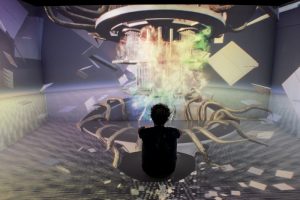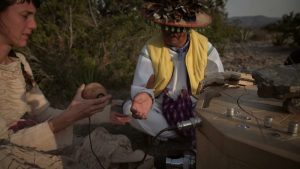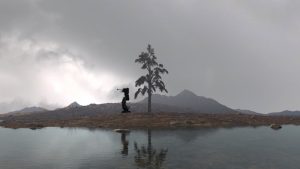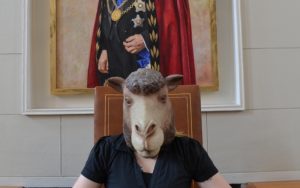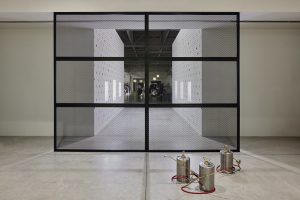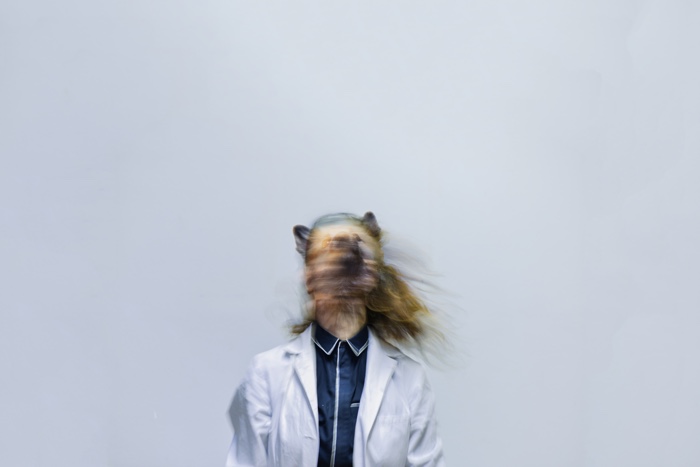
Maja Smrekar, K-9 topology ARTE_mis . Photo: Anze Sekelj and Hana Josic
Maja Smrekar has spent the past few years investigating human/dog/wolf co-evolution, co-habitation as well as the possibility to create a hybrid of the human and the dog species. Her K-9_topology work places this co-evolution at the center of a broader reflection around humanity, its presumption to have an innate right to rule over other living entities and the consequences this self-centeredness is having on the very future of our planet (or at least of our existence upon it.)
K-9_topology evolved over a period of several years and is articulated around four artworks. The first, Ecce Canis, involved isolating serotonin from the blood of both the artist and her dog companion Byron to transform it into an odor that permeated a gallery installation. The fragrance symbolized the olfactory basis of their relationship and by extension the long history of mutual tolerance and taming of both species.
Maja Smrekar, I Hunt Nature and Culture Hunts Me (video extract of the performance) at Rencontres Bandits-Mages, 2014
The second project in the series, I Hunt Nature, and Culture Hunts Me took place at the JACANA Wildlife Studios in France, where she worked with animal ethologists to establish a relationship of trust with wolves and wolf dogs.
Hybrid Family is the third chapter in the series. In this long duration performance, Smrekar biologically manipulated her body so that she could use her own breast milk to feed an Icelandic Spitz puppy. The process took place in a retreat in the company of Smrekar’s dog companion Byron. The three of them thus literally formed a hybrid family in which the exploration of transpecies motherhood broke away from the confines of human families, “without humanizing the animal or animalizing the human.”
Finally, the project ARTE_mis enabled her to further explore co-evolution of humans and dogs by suggesting the possibility to create a hybrid creature. One of her emptied ova was used as a host for a somatic cell of her dog Ada. The resulting hybrid cell was never meant to become a chimera, as it is an artistic attempt of questioning the current biotechnological possibilities, from which the impossibility of the mythological man-wolf emerges in all its poetics. Instead, it suggested that if we care for Planet Earth and our survival upon it, we might as well morph into creatures that treat their environment with more consideration than we do.
Behind its spectacular and, for some, controversial guises, K-9_topology offers us the opportunity to reflect on uncomfortable issues such as the instrumentalization of female bodies, the problematic position of the human species at the top and center of the ecosystem, the ambiguities of biotechnological practices and promises, the prospect of a post-human world, etc.
Maja Smrekar, K-9_topology
I caught up with the artist for an interview about K-9_topology:
Hi Maja! First of all, i’d like to ask the obvious question: the controversy that the works raised. It seems that some (lazy) journalists were so shocked and incensed by your performances that your gallery Galerija Kapelica had to publish a statement to clarify all misunderstandings and misinterpretations. I’m sure you were expecting controversy. But was it something that was part of the initial plan? Something that you’d use to fire up and deepen the conversation? Or was it just an inevitable byproduct of a brave and thought-provoking project?
Obviously some kind of a reaction could have been anticipated, especially in the light of the forthcoming elections last year in Austria where it all started and continued just recently in Slovenia, again regarding the forth coming elections. Despite the official public clarifications of my work process by Ars Electronica and later by Kapelica Gallery, in the next months, this fake news with additional (mis)interpretations got pulled into a vortex of online negative virality. I understand these events as a symptomatic proof of concept on the times we live in, which are clearly established as a state of some kind of a universal crisis. Reactions to this crisis range from a diverse plethora of fundamentalism to the right-wing populism, that put everything not equal to their perception of ”normal” to the opposition, and some parts of the society are consequently becoming more and more conservative. Such radical and aggressive sensationalism needs to be resisted by radical artistic statements and works. I think artists are obligated to address those conditions of neoliberalism which causes a sense of social un-security in people. And people respond to it with great fear that usually manifests in different forms of hate speech. Those kind of reactions are simply built into the system all over the world. Therefore in the light of the above mentioned global atmosphere, I have since the start of my projects felt the need to resist this contemporary cynicism, which in the service of false political correctness in our society essentially rejects everything remotely animalistic.
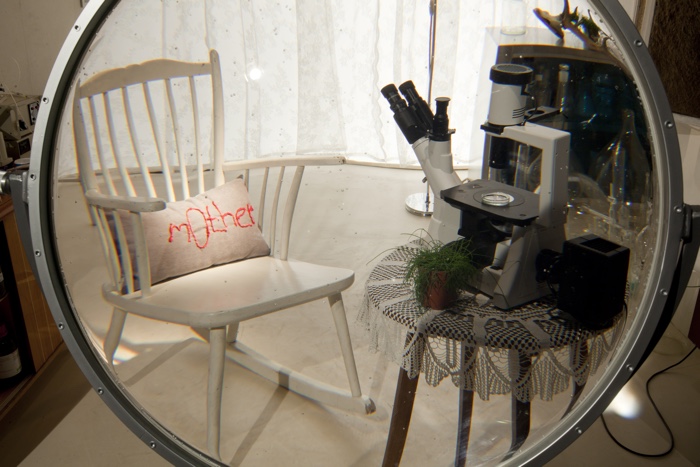
Maja Smrekar in collaboration with Manuel Vason, ARTE_mis, 2016. Photo credit: Miha Fras
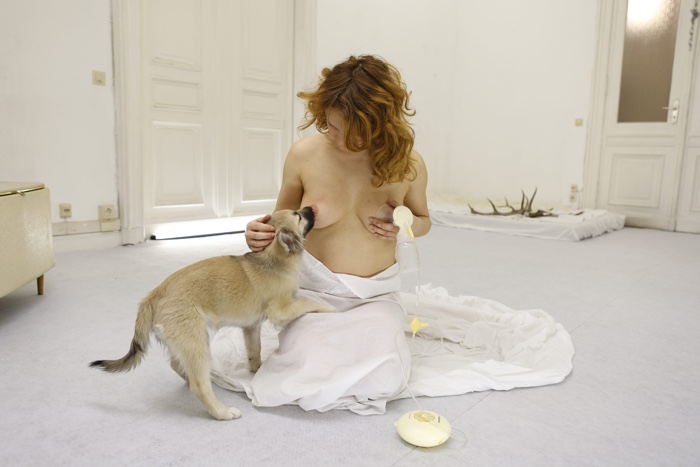
Maja Smrekar in collaboration with Manuel Vason, K-9 topology Hybrid Family, Berlin, 2016
How about scientists? Was it easy to get them on board when you explained them what your performances would be about?
ARTE_mis project was the one that was strongly developed with a proposal through a scientific concept within which I was connecting three carnivorous species: human, dog and wolf. Ever since the beginning of their existence, all three species have been regulating the environment together, although wolf is an endangered species nowadays, whereas humans and dogs have became the largest invasive species on the planet. Therefore I placed our cell materials in an equal cohabitation relationship as an artefact.
What we got was not so much a chimera, as it was an artistic statement! Despite the fact that the project carries a plethora of biotechnological potentials, it at the same time serves as a civil tactical media act. Even though the final cell exists frozen in liquid nitrogen, it also evokes a public discourse and serves as a reference to the theory of Rosi Braidotti, who requires us to think beyond humanist limitations, in order to embrace the risks that becoming other than human will bring in the future.
The scientists I was working with could easily understand this concept. However, due to the before mentioned culture of sensationalism growing within the society of fear ranging from bio phobia, to bio phascination, they choose not to be mentioned in the credits of my last project. I think that was a smart decision.
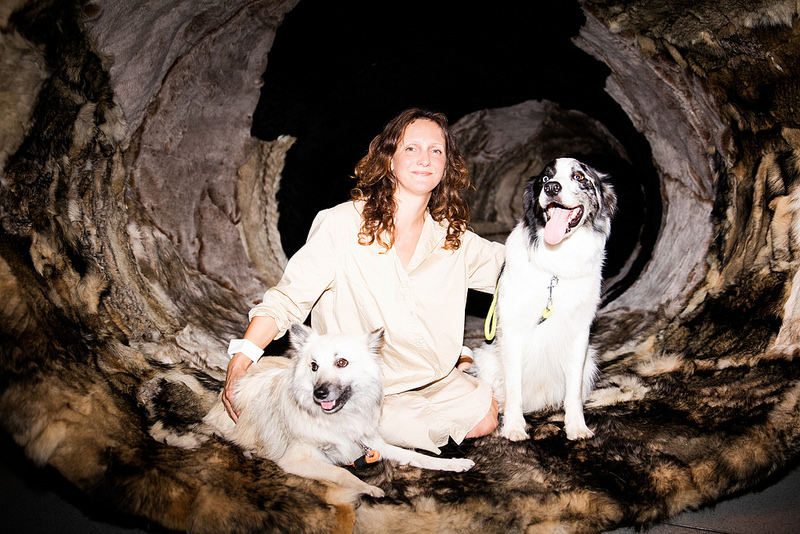
Maja Smrekar, K-9_topology: ECCE CANIS. Credit: Ars Electronica / Florian Voggeneder
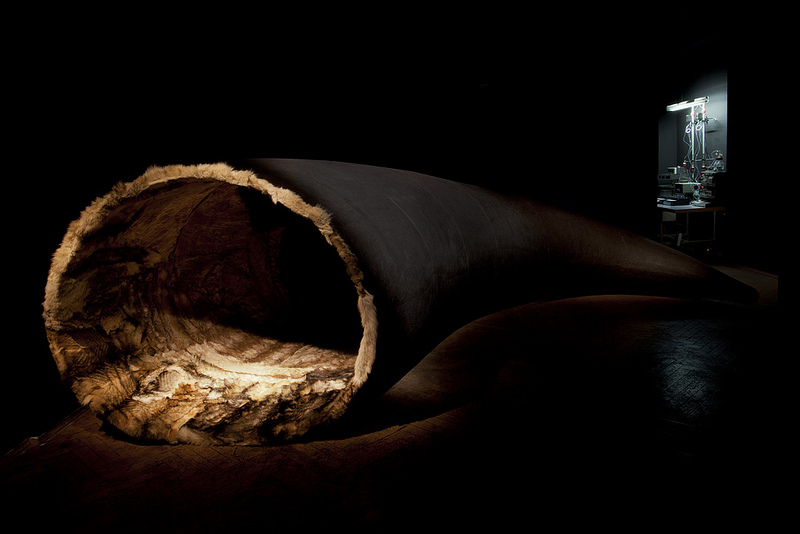
Maja Smrekar, K-9_topology: ECCE CANIS. Credit: Maja Smrekar
Were there moments when you realized that being an artist gave you more agency than if you had been a scientist? What are you allowed to do research, experiment with and perform that a scientist would be forbidden to do?
I think the regulations within the law and its consequences should always be considered on all sides. One of the main differences between the fields is the approach regarding methods of work. I do not think that the collaboration between scientists and artists is a competition in terms of which area could offer more possibilities, especially since as an artist, I use science in my work as an artistic media that communicates an important message: science and technology are present in every pore of our everyday life, so I think it is necessary to address them when we are dwelling on the aspects of contemporary society.
Works like ARTE_mis and Hybrid Family defy traditional views related to the female body, its accepted functions and its purposes. So i’m tempted to see a feminist statement in these performances. Was there indeed a feminist element in your approach of the works?
Absolutely. Hybrid Family with the whole durational breast pumping act was addressing the postindustrial perspective of the dominant service activity on which the sociological and ideological positions of motherhood are based, and as such the breastfeeding instrumentation as its derivative. The next step in the project was to establish an emphatic distance towards the Other. At a public presentation in my then established studio in Berlin, visitors were witnessing the feeding of a puppy Ada with my colostrum, while discussing reproductive freedom in a hetero normative society in which the concept of a traditional family seems to be an increasingly problematic illusion.
The concept for the ARTE_mis clearly grew out of the Hybrid Family but it also contains a further observation on our zeitgeist. In the face of disappearing natural resources and the increasing demand for them, the global migration flows, overpopulation and consequently threats to the environment and biodiversity, all evoked by a globalized capitalist system that seems to pursue its path of destruction until everything is consumed, I was dwelling on the myth of humanity, which has been based on universal values and our exceptionalism, always excluding some that didn’t correspond to the ideal which underlies the apparent.
There have always been fine gradations within the category of the human, according to gender, race, class, culture, nation, religion, species and so on. Therefore, not all of us can say, with any degree of certainty, that we have always been human, or that we are only that. Within a synergy of Hybrid Family and ARTE_mis I placed myself in the ultimate position of the Other, whereas through my body as well as bodies of my dog companions, I was therefore trying to initiate a debate on what conventional law based ethical phrases such as “compromising human dignity” even mean?
The 4 chapters of K-9_topology have now been completed. Did you, at any point, have to rethink your assumptions and initial beliefs? Did your project hit some limitations you had not expected? For example, in terms of interspecies communication, possibilities to create a genetic hybrid of the two species, technical procedures, etc. Did you hit walls, constraints that you had not contemplated?
I already start every new project with the assumption that nothing is going to be at the end as anticipated at the beginning, which is very exciting. Every artistic process is built on this kind of dynamics, no matter what art field we are talking about. For one, those technological “problems” are always at work. In a research-based hybrid field, the process of work is most important for composing the whole conceptual frame of the artwork. There are always many options how to achieve as well as interpret the result. Sometimes the process inspires me to take a different course from the one I anticipated at the beginning. That is also one of the crucial differencies between art and science. In art the whole research organically inspires you towards the final conceptual frame whereas in science a result needs to be the same as predicted at the beginning. And most importantly, the result needs to be repeatable.
Regarding the biotechnological infrastructure as one of the most important aspects of this kind of work – I consider myself very lucky to be living in Slovenia and collaborating with Kapelica Gallery, which has, under the Kersnikova Institute in Ljubljana, established BIOTEHNA – a laboratory for artistic research of living systems, where I was able to execute bio technologycal part of my projects along with my collaborators, and fortunately had enough of the equipment, materials, resources, time and space to do so, considering all the troubleshooting that comes along in such process.
As for the inter species communication, in some of my projects my two dog companions, Byron and Ada, have been collaborating with me. Beside executing those projects, between 2011 and 2016, I have been educating along with them in dog sports and dog obedience trainings in Ljubljana, within an institution, registered by the FCI (Federation Cinologique Internationale) – the World Canine Organisation. As a dog handler I have received official certificates. Beside some projects, where I have been collaborating with other animals along with professional ethologists and animal wranglers within which all of them thought me a great deal about inter species communication, I am capable to recognize dog language and react accordingly.
You put your own body into danger. Trying to engage with a wolf pack, submitting your body to a special diet in order to feed a young puppy, etc. Are there legal or indeed ethical limits to what an individual can do with their own body?
I am not particularly interested in the ethical limits regarding how an individual would be treating her or his own body, I am more interested in the ethical limits considering one’s own body that are being set by the legal system. Therefore, by submitting myself to the dog-human kinship in K-9_topology projects, I started claiming myself as an agency that does not only inhabit, but becomes the owner of her own body. I needed to do so. For me personally it would be much more compromising had I not executed those projects the way I did.
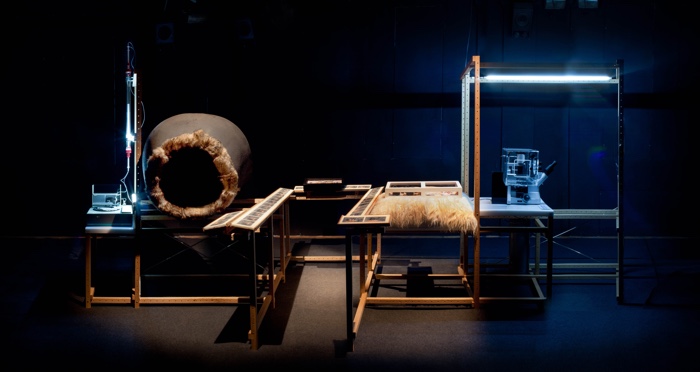
Maja Smrekar, K-9 topology, at Galerija Kapelica. Photo: Miha Fras
K-9_Topology also raises questions about a “(dystopian) future in which biotechnology can create interspecies.” Are we close to this type of future? Is it a question of science not being yet ready for that? Or is it more a question of ethics, with limits to how much you can manipulate human bodies?
For me it is not about the technological possibilities at all. I think it is mostly a question of here and now, in order to defy fear towards the Other as something completely foreign, by being more emphatic. A simple recognition between two beings as the act of noticing and paying attention is a common thread that connects the core of nearly every living being. That is why in K-9_topology the concept which can be, among other interpretations, read as a speculative fabulation, a dog-human werewolf exists as a reminiscence of an extinct culture of man, to stress that we are in this moment living in an extremely cynical society which desperately lacks empathy. So, I think yet in the post human future the main question to ask ourselves will be: What (still) makes us human?
I’d like to discuss the ”Trust Me, I’m an Artist” ethics panel event that took place on 16 November 2018 at Waag Society in Amsterdam with the participation of philosophers, a biologist and other experts. What were the main critiques raised by the panelists?
I believe the main concern was whether it was ethical towards my dog companion Ada offering her to consume my colostrum.
And what were the panelists’ conclusions in terms of whether or not art can contribute meaningfully to the discussions around the ethical issues arising from new (bio)technologies?
I think the panelists should answer this question. All I can say is what we can learn from art history, which is that art is definitively beyond any kind of morality. That is why artists are so important, because we are putting the mirror towards the society with our critical thought that enables understanding the criteria for the evaluation of human activity in a specific time and space. That activity is called culture. I am very much aware that there is a certain price that needs to be payed for being an artist, and I am willing to pay it. That is my ethical obligation.
Thanks Maja!
A previous conversation with the artist: Post-anthropocentric art. An interview with Maja Smrekar.

